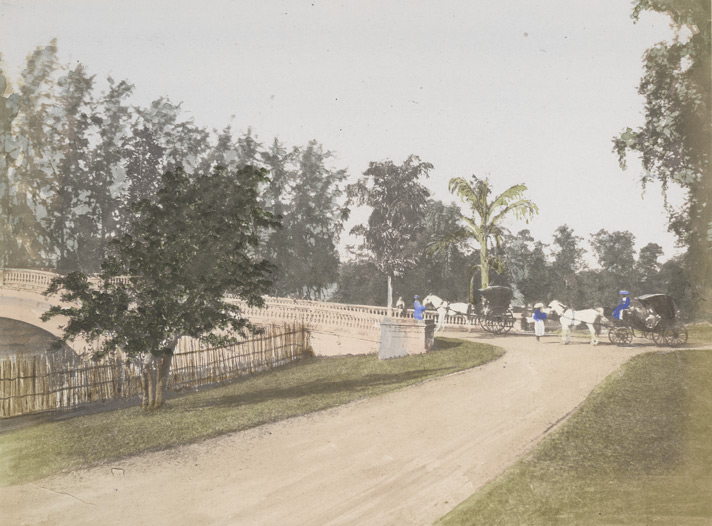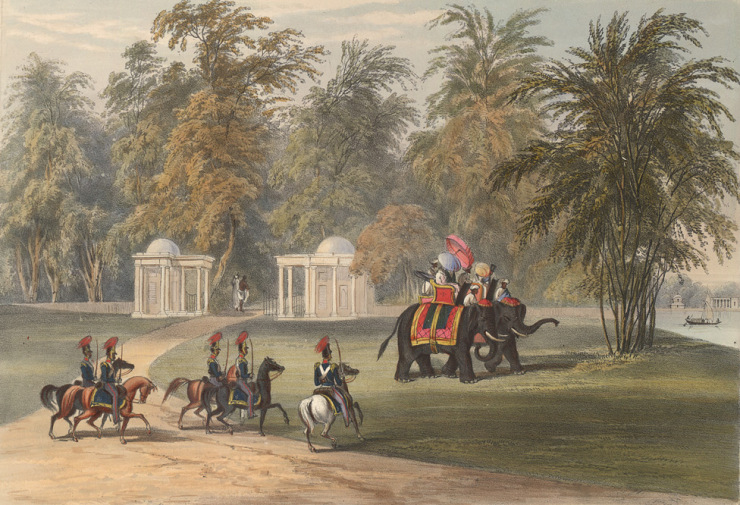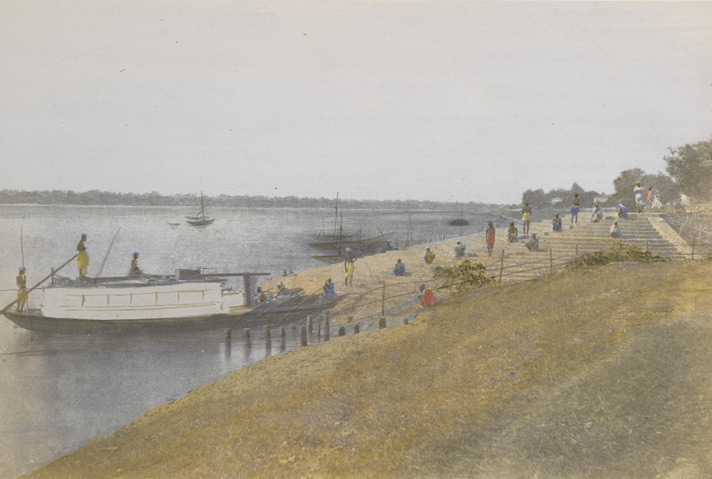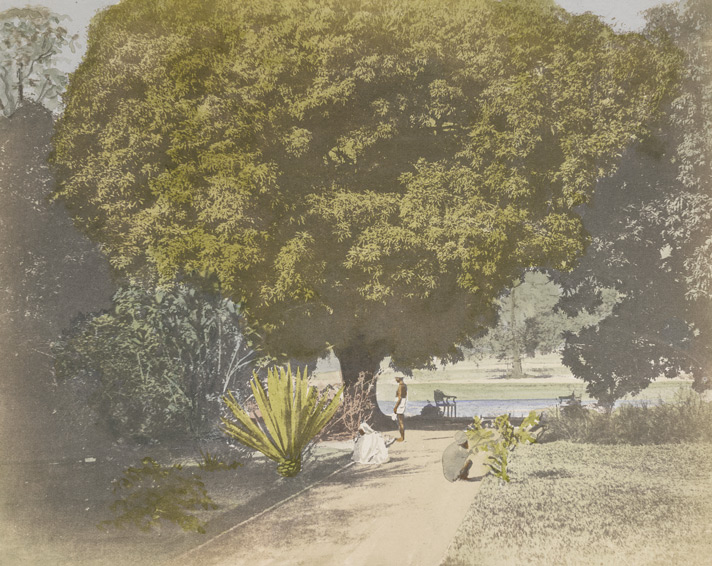
ব্যারাকপুর – কলকাতার অদূরে ‘ছোট কলকাতা’
Barrackpore, some 16 miles away from Calcutta, turned into a little Calcutta or Chhota Calcutta. This happened because of the mastermind of Marquis Wellesley, who moved to Barrackpore in 1801 and occupied the Commander-in-Chief’s residence – one of the two bungalows bought by the Government with 70 acres of land when the cantonment was founded in 1775. This is where Wellesley lived for about 3 years devoting his mind in enlarging and improving the surrounding park area. He landscaped the gardens in the ‘English Style’, added an aviary, a menagerie and a theatre. The rustic hamlet emerged as a fashionable abode of the Britishers for sojourning.
by Ozias Humphry, pencil, chalk and watercolor, 1783
Marquis Wellesley (1760-1842) by Ozias Humphry, 1783
Barrackpore had a long history that began much before the coming of Job Charnock, who had been in Barrackpore for a while, raised a bungalow, and gathered a little bazaar closed by. Here his beloved wife of native origin had died. The area was previously ruled over by a line of Zamindars based in Nona Chandanpukur, Barrackpore. In ‘Ain-e-Akbari’, Abul Fazal (1596–97) referred to this place as Barbuckpur, and it was Chanak in `Manasa Vijay` written by Bipradas Pipilai (1495). Chanak and the other nearby towns were developed into chief marketing, trading and populous towns along the side of river Hooghly. The local name Achanak seems to be a localized version of Chanak.
Barrackpore, however, went into the British colonial history more significantly because of the two revolts. The first one was the 1824 insurgency led by Sepoy Binda Tiwary, and the second was the Sepoy Mutiny of 1857 led by Mangal Pandey. With the exception of these two horrifying experiences of tumult and fury, Barrackpore has always been a calmly country seat for the white’s leisurely pursuits contrary to the demanding living condition of the up-and-coming city of Calcutta.
In pre-Plassey Calcutta, the servants of East India Company used to live in dark and damp lodgings in the Fort, and warehouses where the gates shut upon them at night. After Plassey, the growth of the garrison and the influx of European officers and troops from Madras worsened the lodging condition. New quarters came up along the Avenue, Pilgrim Road, and Bow Bazar and, bypassing the native quarters of Dinga, and Coalinga, spread over the open ground of Chowringhee and Dharmatallah. [See The Social Condition of the British Community in Bengal: 1757-1800 By Suresh Chandra Ghosh. 1970] No wonder that the Europeans, gradually migrated from Tank Square – ‘the Belgravia of that day’ — and took up their abodes in Chowringhee ‘out of town’. [See ‘Calcutta in the olden time — its localities‘ In Calcutta review. Sept.1852.]. Earlier James Atkinson in a verse, published in 1824, described the condition of Calcutta more pungently as ‘an anxious, forced existence’. [ See City of Palaces, a poem by James Atkinson. 1824]

The road from Calcutta to Barrackpore was opened to the public on the 26th of July, 1805, perhaps the best road constructed so far. Miss Emma Robert, the English lady traveler, wrote after two decades, that the ‘drives and rides about the city are not very numerous, nor very extensive, excepting towards Barrackpore.’ [See Scenes and characteristics of Hindostan; with sketches of Anglo-Indian society; v.1 by Emma Roberts. 1835]
In 1830 the Barrackpore Bridge, commonly called, ‘Shyambazar Bridge’, was constructed connecting Barrackpore Road to Calcutta at its northern end. The 100 ft long and 30ft wide Bridge was built by the Canal Superintendent, James Prinsep at the cost of Rs 20,529. It was a beautiful bridge, as revealed in the hand-colored photograph of the bridge and the road with running horses and carriages, taken by Frederick Fiebig in 1851.
J H Stocqueler while journeying through Brarackpur road looked out from his palanquin [ see Hand-book of India, a guide to the stranger and the traveler, ..ed. by Joachim Hayward Stocqueler. 1844], to the pleasing view of an extensive avenue of trees skirted by villages, gardens, and rice-fields. Cox’s Bungalow, the site of a building then used as a stable for relays of horses, was on the right-hand side of the road, and there the first change of relay proceeds onward through Barrackpore Cantonment.

Though a large station, Barrackpore presents an air of quiet and retirement like a country village; which joined to its military neatness and propriety, make it one of the sweetest places in India. The bungalows in four lines stand each separated from the others, every one surrounded by its own corn-ground, flower-garden, and neatly trimmed hedge; while the whole cantonment is at right angles intersected by well-kept roads, smooth as bowling-greens, and has the river in front and the parade ground in the rear. Government-house, and it’s beautiful grounds, are merely separated from the cantonments by a piece of water from the river, over which there is a bridge; and the park, as a drive, is at all times open to the European inhabitants. [See Life in India: Or, The English at Calcutta; v.2 by Monkland. 1828]
maria_callcott_by_thomaslawrence
Maria Graham (b1785-d1842) (in later life, Maria, Lady Callcott) An English travel writer. Portrait by Thamas Lawrence. 1819
How Barrackpore was in the first half of the 19th century can be figured out more from the true-to-life excellent paintings and photographs than the textual documents handed down to us – mostly official transactions and records, and also letters and diaries of the travelers and residents, which provide a human-side view, factual information apart. Unfortunately, not many travel-writers visited Barrackpore. The English lady, Maria Graham(later Lady Callcott) was an exception. In her book, Journal of a Residence in India, she left her lively and credible impressions of everything she saw there. Her account of Barrackpore commenced from Nov 20, 1810.
RIVER-SIDE
It was a delightful day she arrived by boat. The weather was so cool that ‘one really enjoys a river view walk’. Close to Calcutta, it is the busiest scene one can imagine; crowded with ships and boats of every form,—here a fine English East Indiaman, there a grab or a dow from Arabia, or a proa from the eastern islands. On one side the picturesque boats of the natives, with their floating huts; on the other the bolios and pleasure boats of the English, with their sides of green and gold, and silken streamers. Up the river, the scene became quieter but no less beautiful.

The trees grow into the water, and half hide the pagodas and villages with which the banks of the river are covered on both sides. It was late when we arrived here, and some of the pagodas were already illuminated for a festival; fireworks, of which the natives are very fond, were playing on the shore, and here and there the red flame of the funeral fires under the dark trees threw a melancholy glare on the water. From the opposite river bank, The missionaries Serampore had enjoyed the same view of Barrackpore riverside. Carey’s biographer, George Smith reproduced William Carey’s memory of ‘The garden slopes down to the noble river, and commands the beautiful country seat of Barrackpore, which Lord Wellesley had just built’. [See Life of William Carey, by George Smith. 1909]
THE PARK

Many of the Barrackpore goers maintained that it was not the Barrackpore House itself ‘but its accessories were the best features it can boast of’ – an aviary and a menagerie, a garden and a pleasant promenade, where the society of the station assemble, while one of the regimental bands plays upon the greensward, constitute the chief agremens of the place’. [See Hand-book of India, a Guide, ed by Stocqueller. 1844]
When Mrs Graham came to the Park of Barrackpore, the tamarind, acacia, and peepil trees, through whose branches the moon threw her flickering beams on the river, seemed to hang over our heads, and formed a strong contrast to the white buildings of Serampore, which shone on the opposite shore. We landed at the palace begun by Marquis Wellesley, but discontinued by the frugality of the Indian Company; its unfinished arches shewed by the moon-light like an ancient ruin and completed the beauty of the scenery. The area of the whole Park is nearly 350 acres and the cost was £9,577. Lord Wellesley started acquiring the land and making the Park. In the North-East corner, he established the menagerie that continued to exist till the Zoological Gardens at Calcutta opened in 1876.
MENAGERIE

“A little nulla, or rivulet supplies several fine tanks in the park, which embellish the scenery and furnish food for a number of curious aquatic birds kept in the menagerie. The pelican, whose large pouch contains such an abundant supply of food, the produce of her fishing, for her young; the syrus, or Sarasa, a species
of stork, whose body is of a delicate grey color, and whose head, which he carries above five feet from the ground, is of a brilliant scarlet, shading off to the pure white of his long taper neck; and the flamingo, whose bill and wings are of the brightest rose-color, while the rest of his plumage is white as snow,—are the most beautiful of those who seek their food in the water. Among their fellow-prisoners are the ostrich, whose black and white plumes attract the avarice of the hunter; the cassowary, whose stiff hard feathers appear like black hair; and the Java pigeon, of the size of a young turkey, shaped and colored like a pigeon, with a fan-like crest, which glitters in the sun like the rainbow. [Graham]
the North-East corner of the Park known as Chiriakhana. The Governor General’s elephants used to be kept at Barrackpore. The place across the Grand Trunk Road to the North North-East of the Park was known for a long while as Hatikhana, although the last of the elephants were sold in Lord Elgin’s time. It was here in the Park that the poet-bishop first mounted an elephant — “the motion of which,” he confesses, “I thought far from disagreeable, though very different from that of a horse.” [See Thacker’s Guide to Calcutta ed. by Walter Kelly Firminger. 1906]
On Nov. 25, she wrote ‘The north winds are now so cold, that I find it necessary to wrap up in a shawl and fur tippet when 1 take my morning’s ride upon one of the governor-general’s elephants, from whose back I yesterday saw the Barrackpore hounds throw off in chase of a jackal’. “The quadrupeds in the menagerie are only two royal tigers, and two bears, one a very large animal, precisely like the bears of Europe; the other was brought here from Chittagong, where it is called the wild dog. His head is shaped like that of a dog, but bare and red about the muzzle; his paws are like those of the common bear, but his coat is short and smooth; he refuses to eat any kind of vegetable food, which the large bear prefers to flesh, and is altogether the most ferocious creature I ever saw. ”
GAITIES
On December 5, 1810, Graham was in great expectation of the festivity in Barrackpore. In three weeks, she mused, all the gay world will be assembled at Barrackpore, on account of the races, which are run close to the park-gate. This year there will be little sport, as the horses are indifferent, but I am told the scene will be very gay, “ with a store of ladies, whose bright eyes rain influence”. Barrackpore had a tradition of public merriments to celebrate important events. Three years ago. On the 12th of September 1807, Barrackpore celebrated the anniversary of the battle of Delhi. A splendid entertainment was given in ‘the new Theatre at Barrackpore’ at which were present the Right Hon’ble Lord Minto, the Governor-General, General St. Leger and Staff, the whole of the officers and ladies at the station, and a numerous party of visitors from Calcutta. [See Life of William Carey, by George Smith. 1909]
Lord Wellesley was not in favor of horse race. He stopped horse racing and all sorts of gambling as soon he arrived in India; yet at the end of November 1809, there were three days’ races at a small distance from Calcutta. After a lull, the Calcutta Races again commenced under the patronage of Lord Moira. Stocqueler tells us “there at Barrackpore a race-ground existed, but races have not taken place anymore. The sports of the place are confined to an occasional steeple-chase, a run with the Calcutta hounds, and a few balls and public dinners.” [See Hand-book of India, a Guide, by Joachim Hayward Stocqueler. 1844]

In the Park, there was also an excellent golf link much resorted to by Calcutta folk. Closer to the house there was a vast banyan tree beneath whose shade many a viceregal tiffin-party had assembled. Mrs. Graham had some fascination for Indian custom s and traditions. On the first day she mentioned in her journal whatever she had seen on the river bank – the illuminated Hindu pagoda, festivity, fireworks, and the melancholy glare of the flame of the funeral – all important elements of Hindu life in a flash.
The cultural difference between the European and Asiatic societies did not deject her spirit of inquiry and appreciation of the estranged tradition of India. She writes: “The other day, in going through a small bazaar near one of the park gates, 1 saw five ruinous temples to Maha Deo and one in rather a better state to Kali. As 1 had never been in a pagoda dedicated to her by that name, I procured admittance for a rupee. Her figure is of brass, riding on a strange form that passes here for a lion, with a lotus in the place of a saddle. Her countenance is terrific; her four hands are armed with destructive weapons, and before she is a round stone sprinkled with red dust. The sacrificial utensils are mostly of brass; but I observed a ladle, two lamps, and a bell of silver; the handle of the bell was a figure of the goddess herself. The open temple in the square area of the pagoda has been very pleasant, but is now falling into ruin, as are the priest’s houses and everything around.”

As it shows, Graham was not unfamiliar with the Hindu themes of deities, and also her feelings on seeing the ruinous state of the temple. In a later note, however, she showed her deep concern, silently, about the desperate order of the native society, while recounting the horrid scene of dead bodies uncaringly floating in the river, vividly and dispassionately.
Bodies of the Dead
“The other night, in coming up the river, the first object I saw was a dead body, which had lain long enough in the water to be swollen and to become buoyant. It floated past our boat, almost white, from being so long in the river, and surrounded by fish; and as we got to the landing-place, I saw two wild dogs tearing another body, from which one of them had just succeeded in separating a thigh-bone, with which he ran growling away. Now, though I am not very anxious as to the manner of disposing of my body, and have very little choice as to whether it is to be eaten by worms or by fishes, I cannot see, without disgust and horror, the dead indecently exposed, and torn and dragged about through streets and villages, by dogs and jackals. Yet such is the daily sights on the banks of the Hoogly. I wish I could say they were the worst; but when a man becomes infirm, or has any dangerous illness, if his relations have the slightest interest in his death, they take him to the banks of the river, set his feet in the water, and, stuffing his ears and mouth with mud, leave him to perish, which he seldom does without a hard struggle; and should the strength of his constitution enable him to survive, he becomes a pariah; he is no longer considered as belonging to his family or children, and can have no interest in his own fortune or goods. About thirty miles from Calcutta, there is a village under the protection of the government, entirely peopled by these poor outcasts, the numbers of whom is incredible.
Earlier, Graham expressed her mind loudly and clearly– reacting to the unconditional submission of the Hindoos to the evils of the caste system. She felt degraded seeing the half-clothed, half-fed people, covered with a loathsome disease, without attempting ever to overstep the boundaries which confine them to it indelibly. “Perhaps there is something of pride in the pity”, she says, “I cannot help feeling for the Lower Hindoos, who seem so resigned to all that I call evils in life”. The story of this hapless lot stands in glaring contrast to the vibrant city life of Barrackpore.
The park-city of Barrackpore was designed and developed by the British and the British. It was an English garden Lord Wellesley planned and laid there. An English theatre, ballroom, race-ground, golf-link, a Hotel Charnock came in place for their entertainment. There was something in the scenery of this place that reminds Maria Graham of the beauty of the banks of the Thames; ‘the same verdure, the same rich foliage, the same majestic body of water’.
The local inhabitants were, however, never allowed to enter the park-area except for work. Graham met a few of them while moving around, and had glimpses of their repulsive way of life. Graham never tried to pass judgment, nor any advice either. She questioned about the root of their malady – ‘how they came into the state, and what could amend it’. The spontaneous reply she received was: “It is the custom — it belongs to their caste to bear this”. At the end of the century, Swamy Vivekanada found the key to her final question what unfortunately remains ignored ever since.

Can you provide a map of Barrackpore-Nilganj-Barasat-Jhikhargacha of British period (1945-1946)? I am also in search of pictures of Prisoners of War (WW II) camps around this area.
Thanks and regards.